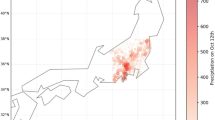Abstract
The historical frequency, distribution and impact of tropical cyclones, severe thunderstorms and bushfires in Australia are discussed. Although the climatological record of frequency and distribution is incomplete for some hazards, this information is more reliable than that available on the impacts of the hazards. Insurance payout costs form the best quantitative measure of negative impacts, but such figures represent only a fraction of the true costs of damage from severe weather. For tropical cyclones the insurance payout since 1967 has been $1715 million, for severe thunderstorms $1808 million and for bushfires $488 million. Tropical cyclones and storms each result in the loss of 4 to 6 lives each year, while bushfires have an average annual death toll of about 10. Although significant benefits arising from severe weather events can also be identified, quantitative estimates of their alue are not available.
Similar content being viewed by others
References
Beer, T., Gill, A. M., and Moore, P. H. R.: 1988, ‘Australian Bushfire Danger under Changing Climatic Regimes’ in Pearman, G. I. (ed.),Greenhouse: Planning for Climate Change, CSIRO, pp. 421-7.
Bureau of Meteorology: 1986, ‘Submission for Upgrading Fire Weather Services’, Severe Weather Warning Services Program Office, Bureau of Meteorology, Australia, 63 pp.
CSIRO: 1990, ‘Regional Impact of the Enhanced Greenhouse Effect on Victoria’, Annual Research Report, CSIRO, Division of Atmospheric Research, Aspendale, Victoria, 40 pp.
Emanuel, K. A.: 1987, ‘The Dependence of Hurricane Intensity on Climate’,Nature 326, 483–485.
Holland, G. J., McBride, J. L., and Nicholls, N.: 1988, ‘Australian Regional Tropical Cyclones and the Greenhouse Effect’, in Pearman, G. I. (ed.),Greenhouse: Planning for Climate Change, CSIRO, pp. 438-55.
Kessler, E. and White, G. F.: 1983, ‘Thunderstorms in a Social Context’, in Kessler, E. (ed.),The Thunderstorm in Human Affairs, University of Oklahoma Press, pp. 3-18.
Lourensz, R. L.: 1981, ‘Tropical Cyclones in the Australian Region’, Bureau of Meteorology, Australia, 94 pp.
Love, G.: 1988, ‘Cyclone Storm Surges: Post Greenhouse’, in Pearman, G. I. (ed.),Greenhouse: Planning for Climate Change, CSIRO, pp. 202-15.
Luke, R. H. and McArthur, A. G.: 1978,Bushfires in Australia, Australian Government Publishing Service, 359 pp.
Milton, D.: 1978, ‘The Rainfall from Tropical Cyclones in Western Australia’, Working Paper No. 13, Dept. of Geography, University of Western Australia, 60 pp.
Solow A. and Nicholls, N.: 1990, ‘The Relationship between the Southern Oscillation and the Tropical Cyclone Frequency in the Australian Region’,J Clim. 3, 1097–1101.
Yu, B. and Neil, T.: 1991, ‘Global Warming and Regional Rainfall: The Difference between Average and High Intensity Rainfalls’,Int. J. Climatol. 11, 653–61.
Author information
Authors and Affiliations
Rights and permissions
About this article
Cite this article
Ryan, C.J. Costs and benefits of tropical cyclones, severe thunderstorms and bushfires in Australia. Climatic Change 25, 353–367 (1993). https://doi.org/10.1007/BF01098381
Received:
Revised:
Issue Date:
DOI: https://doi.org/10.1007/BF01098381




